APAC Bio-ethanol Market Size
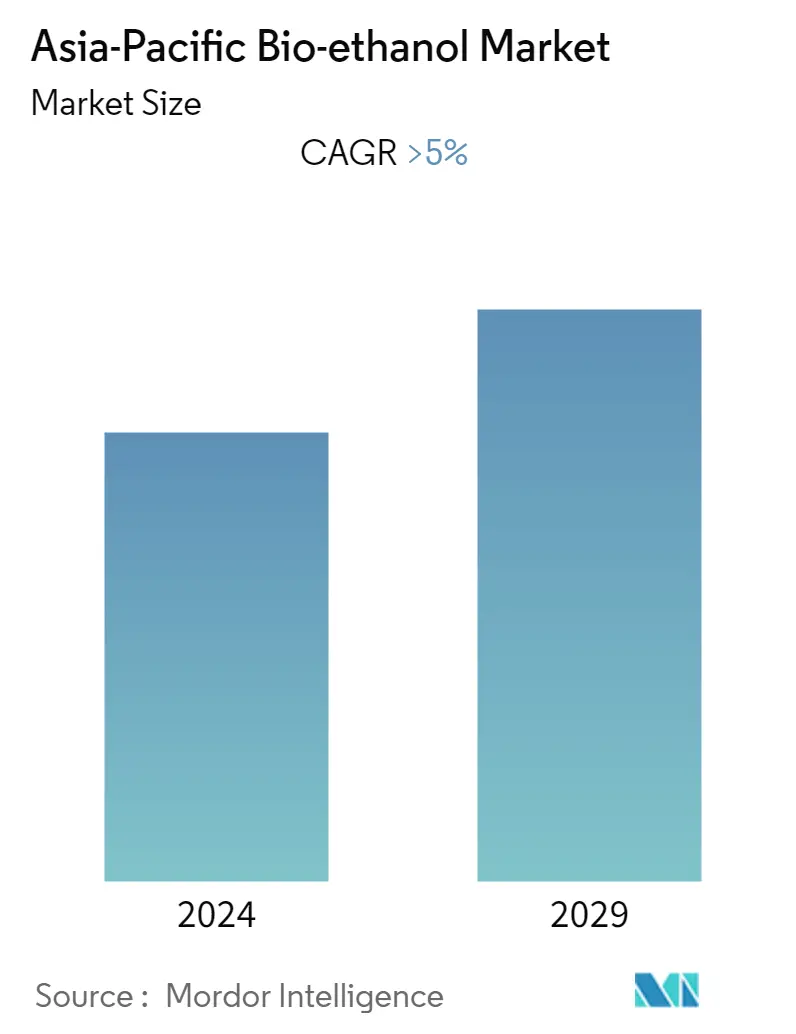
| Study Period | 2019 - 2029 |
| Base Year For Estimation | 2023 |
| Forecast Data Period | 2024 - 2029 |
| Historical Data Period | 2019 - 2022 |
| CAGR | > 5.00 % |
| Market Concentration | Low |
Major Players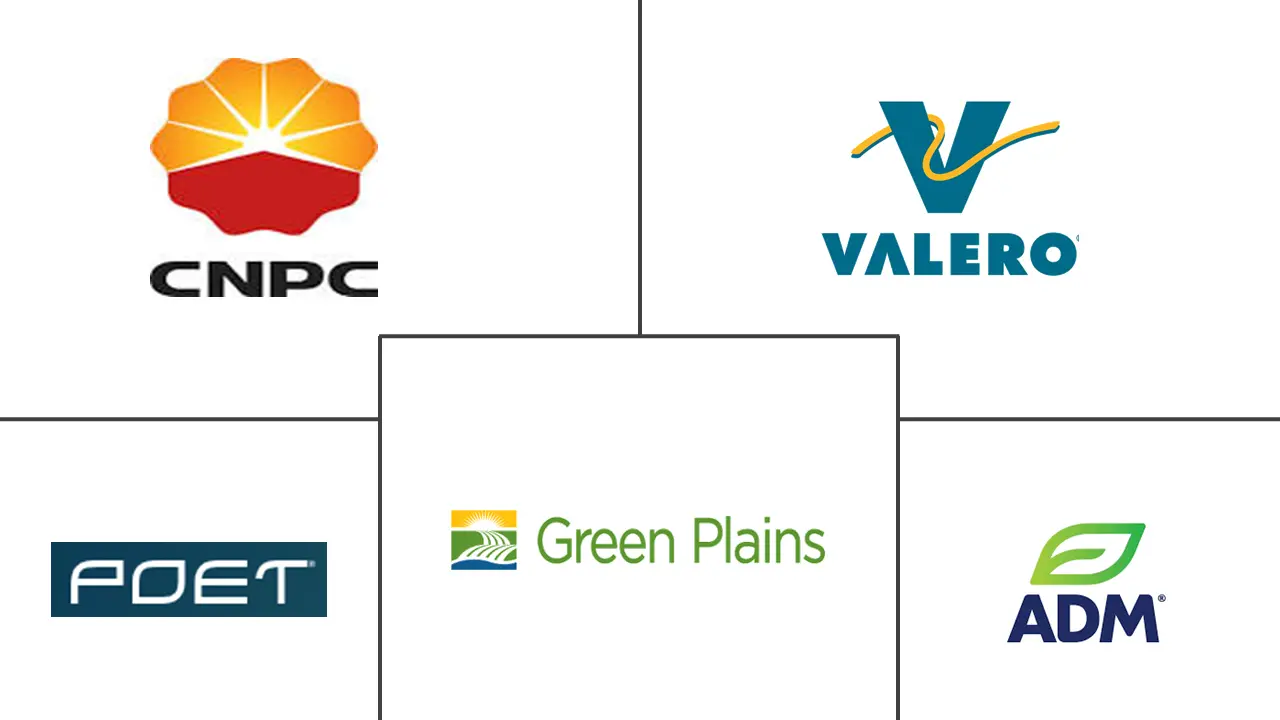
*Disclaimer: Major Players sorted in no particular order |
APAC Bio-ethanol Market Analysis
The Asia-Pacific Bio-ethanol market is anticipated to register a CAGR greater than 5% during the forecast period.
During the outbreak of COVID-19, there was a negative impact on the bio-ethanol market in the Asia-Pacific region due to disruptions in the supply chain. However, the market began to recover in 2021. The significant factors of the industry are increased government initiatives and the relaxation of prohibitions on marketing gasoline with a more substantial proportion of ethanol. The Asia-Pacific Bio-ethanol market has recovered from the pandemic and is growing significantly.
- Over the short term, increasing favorable initiatives, blending mandates by regulatory bodies, and growing environmental concerns due to the use of fossil fuels and the need for biofuels are projected to fuel market growth throughout the forecast period.
- However, fuel-based vehicles are being phased out due to rising demand for electric cars, and a shift in priority to bio-butanol is the significant factor that is likely to hamper the growth of the Asia-Pacific bio-ethanol market size.
- Nevertheless, over the forecast period, second-generation bio-ethanol production and increased bio-fuel consumption in the aviation industry are likely to create lucrative delivery opportunities for the Asia-Pacific Bio-ethanol market.
APAC Bio-ethanol Market Trends
This section covers the major market trends shaping the Asia Pacific Bio-ethanol Market according to our research experts:
Automotive and Transportation Segment to Dominate the Market
- The automotive and transportation industries are significant bio-ethanol users, which is utilized as a fuel blending ingredient. Bio-ethanol is a cost-effective and ecologically friendly alternative to petroleum and gasoline-powered road vehicles.
- Bio-ethanol has a high-octane number, a high heat of vaporization, and a similar energy content to gasoline. Because of these qualities, it can replace lead as an octane booster. Bio-ethanol's enhanced oxygenation in mixing fuels improves efficient combustion, lowering polluting emissions.
- Bio-ethanol is also utilized as a raw material in the production of ETBE (ethyl-tertiary-butyl-ether), a well-known octane enhancer used in conjunction with gasoline. The amount of bio-ethanol blended with conventional fuels enhances their renewability, which is proportional to the blending percentage.
- The benefits of bio-ethanol blended fuels have also lured the aircraft industry, which is eager to embrace the low-carbon to reduce the massive amount of GHG emissions in the environment. Bio-ethanol has enormous potential for use as aircraft fuel. A large amount of research is being directed toward the development of low-cost, engine-compatible bio-ethanol for jet fuel applications.
- The Chinese automobile industry has been a significant driving factor in China's economic momentum, and despite slowing growth, it is likely to continue fuelling the economy. According to the China Association of Automobile Manufacturers (CAAM), in 2021, China was the world's biggest automobile producer, producing around 21.48 million passenger vehicles and accounting for 29.7 percent of worldwide vehicle production.
- According to the Organisation Internationale des Constructeurs d'Automobiles (OICA), the number of passenger cars produced in India was 6.61million approximately in 2021.
- According to the study, growing the overall ethanol-to-blending rate from 6% to 20% by 2030 may be accomplished if ethanol is created from sugarcane juice. According to the National Institution for Transforming India (NITI Aayog), to attain the 20% objective, India's ethanol output needs to grow to 10.2 billion liters, including 5.5 billion liters from sugarcane and 4.7 billion liters from grains. India had achieved ethanol blending of up to 9.45% by 2021-22.
- According to the Ministry of Economy, Trade, and Industry (METI) and the Japan Automobile Manufacturers Association (JAMA), Japan manufactured roughly 7.85 million motor cars in 2021, down from approximately 8.07 million units the previous year. Japan's motor vehicle manufacturing volume includes passenger cars, lorries, and buses, with passenger cars accounting for the bulk.
- All the above factors are expected to drive the automotive and transportation segment, enhancing the demand for bio-ethanol during the forecast period.
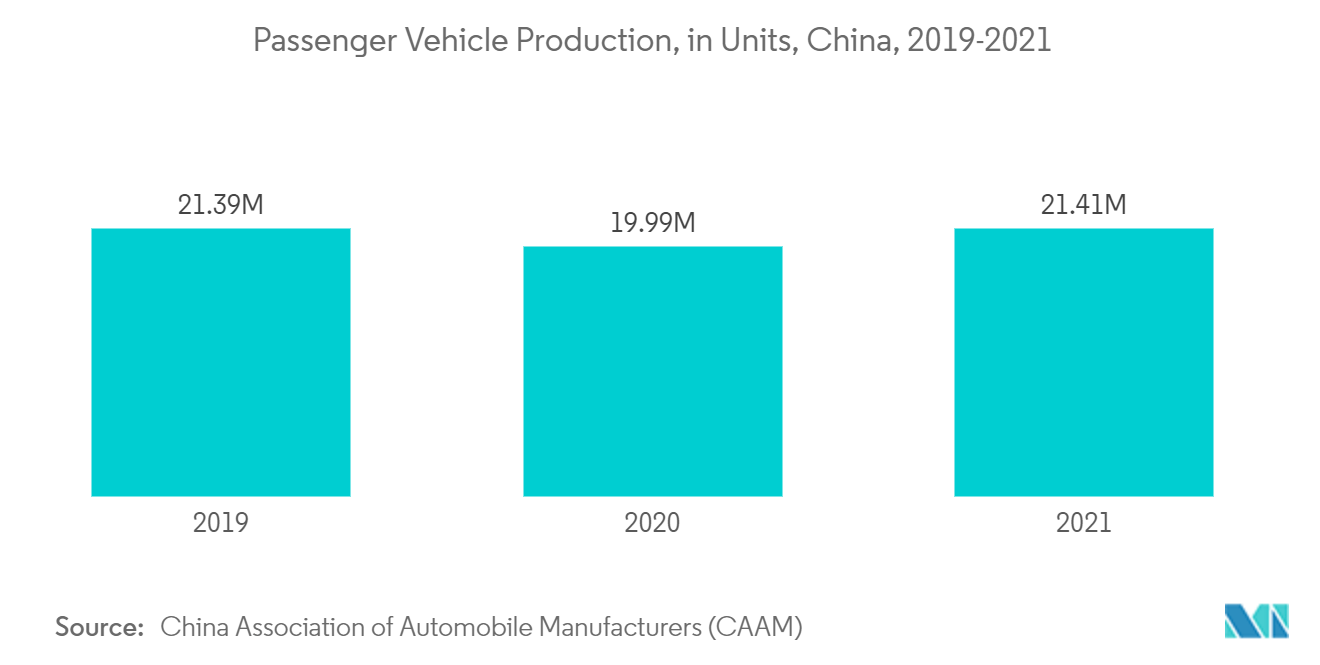
China is Anticipated to Hold a Major Share of the Asia-Pacific
- China holds a prominent share of the Asia-Pacific bio-ethanol market in terms of market share and market revenue. The region is set to continue to flourish in its dominance over the forecast period.
- According to China's bioethanol promotion policy, by 2030, the nation hopes to boost net imports to 26 million metric tons. Meanwhile, due to the country's bioethanol promotion program, China's maize self-sufficiency ratio will fall to 92% in 2030. Furthermore, it has the potential to raise the global maize price index by 5% and the global bioethanol price index by 4% by 2030.
- Until recently, China was a net ethanol importer. The majority of the ethanol came from the United States. However, as a result of the trade war between China and the United States, the Chinese government has imposed tariffs on United States ethanol imports, prompting the US to withdraw from overall commerce in China.
- However, due to the growing cost of crude oil and China's greater reliance on the sector, many provinces in China, especially in the south, imported "approximately 200 million gallons" of US ethanol in the first half of 2021, matching the country's previous record for yearly ethanol imports.
- China is the world's largest vehicle producer. Owing to increased environmental concerns, the country's automobile sector has been preparing for product evolution, with the country focused on creating cars that assure fuel efficiency while limiting emissions. According to the Organisation Internationale des Constructeurs d'Automobiles (OICA), in 2021, the country's automobile output reached 26.08 million, a 3% increase over the 25.23 million vehicles produced in 2020. The increased production of automobiles is expected to raise the demand for bio-ethanol.
- Bio-ethanol is utilized in the healthcare industry to improve applications in medicine such as cancer treatments, illness diagnostic tools, tissue engineering, implants, DNA sequencing, biomarkers, genetic material transfer, and the integrated area of biomedical imaging and neurology. Furthermore, bio-ethanol is employed in a wide range of biomedical applications, including drug/gene delivery, biological sensing and imaging, antimicrobial polymers, and biocompatible scaffolds for cell culture.
- China has the world's second-largest healthcare market. The country does, however, import highly advanced implants from industrialized economies. The country's public hospitals are the country's largest buyers of medical devices.
- China holds a considerable market share in the global medical device industry. According to the State Administration for Market Regulation (China), there were about 27,496 medical device businesses operating in the nation as of the first half of 2021, up from 26,465 in 2020. Mindray Medical, Intco Medical, Lepu Medical, Zhejiang Orient Gene, Shinva, and others are among the leading medical equipment companies.
- Thus, all the above-mentioned factors are likely to provide the increasing demand for the Asia-Pacific bio-ethanol market during the forecast period.
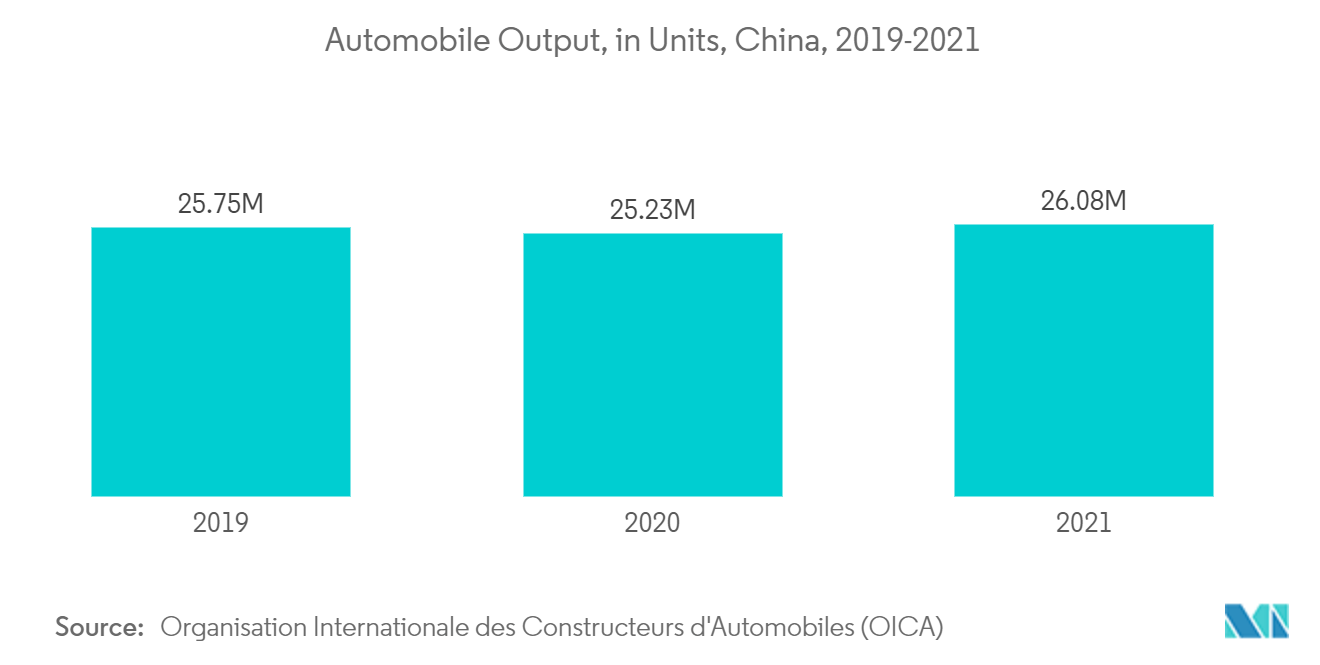
APAC Bio-ethanol Industry Overview
The Asia-Pacific Bio-ethanol market is moderately fragmented. Some major manufacturers in the market include Jilin Fuel Ethanol Co. Ltd (CNPC), POET, LLC., Valero, ADM, and Green Plains Inc., among others (in no particular order).
APAC Bio-ethanol Market Leaders
-
POET, LLC.
-
Valero
-
ADM
-
Green Plains Inc.
-
Jilin Fuel Ethanol Co. Ltd (CNPC)
*Disclaimer: Major Players sorted in no particular order
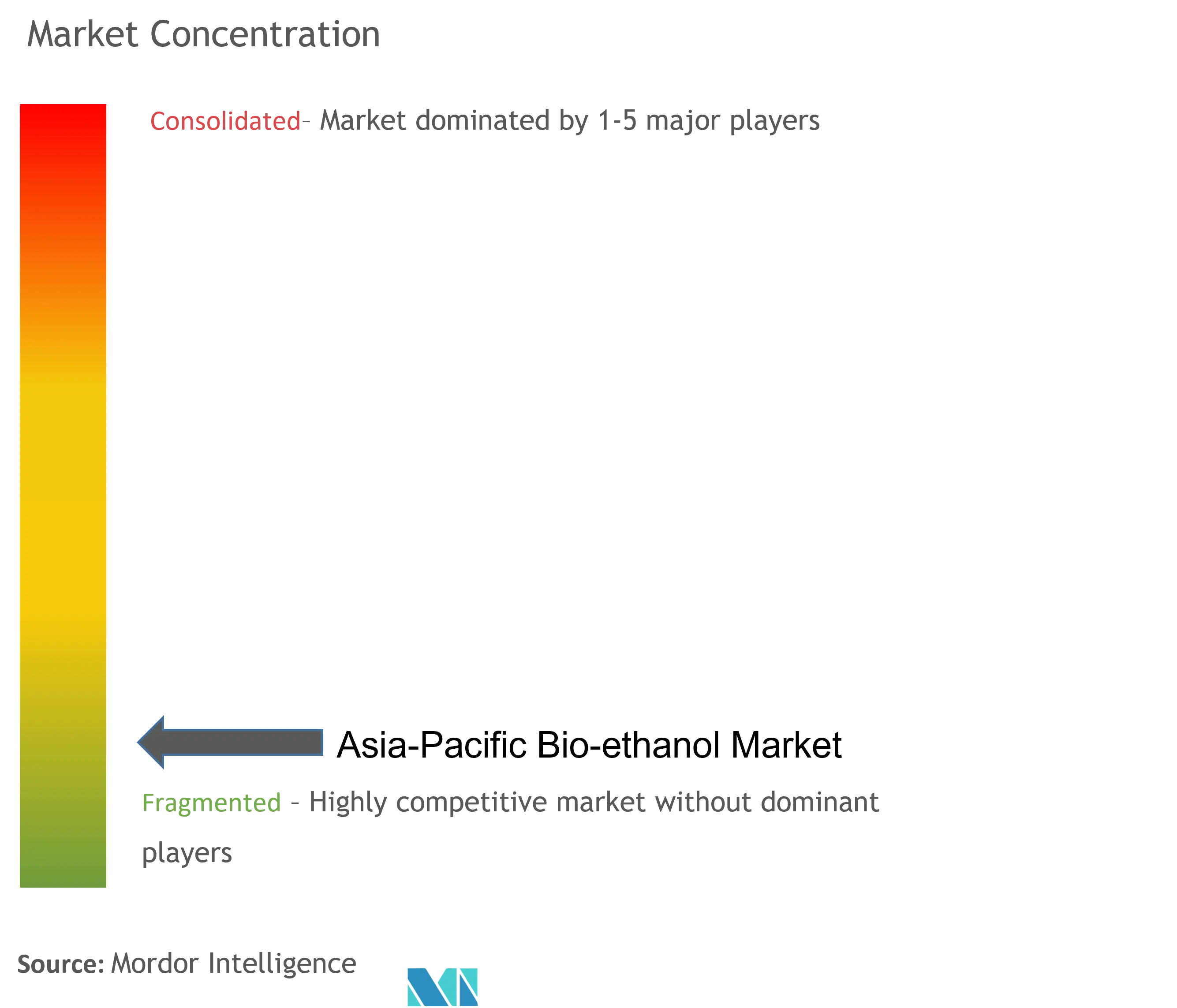
APAC Bio-ethanol Market News
- In November 2022, Andhra Pradesh received a bioethanol facility worth Rs 270 crore (USD 32.67 million). Chief Minister YS Jagan Mohan Reddy laid the foundation stone at Gummalladoddi village of East Godavari district. The facility will be built by Assago Industrial Private Limited and employ 300 people directly and 400 indirectly.
- In August 2021, VERBIO AG signed a Memorandum of Understanding (MOU) with Indian Oil Corporation Ltd. to establish biofuel projects and compressed biogas facilities. This MOU calls for the formation of a Joint Venture Company to generate biomethane, bioethanol, and biodiesel and market them through Indian Oil's network.
APAC Bio-ethanol Market Report - Table of Contents
1. INTRODUCTION
1.1 Study Assumptions
1.2 Scope of the Study
2. RESEARCH METHODOLOGY
3. EXECUTIVE SUMMARY
4. MARKET DYNAMICS
4.1 Drivers
4.1.1 Increasing Favorable Initiatives and Blending Mandates by Regulatory Bodies
4.1.2 Growing Environmental Concerns due to the Use of Fossil Fuels and the Need for Biofuels
4.2 Restraints
4.2.1 Phasing out of Fuel-based Vehicles Due to Rising Demand for Electric Vehicles
4.2.2 Shifting Focus to Bio-butanol
4.3 Industry Value Chain Analysis
4.4 Porter's Five Forces Analysis
4.4.1 Bargaining Power of Suppliers
4.4.2 Bargaining Power of Buyers
4.4.3 Threat of New Entrants
4.4.4 Threat of Substitute Products and Services
4.4.5 Degree of Competition
5. MARKET SEGMENTATION (Market Size in Volume)
5.1 Feedstock Type
5.1.1 Sugarcane
5.1.2 Corn
5.1.3 Wheat
5.1.4 Other Feedstocks
5.2 Application
5.2.1 Automotive and Transportation
5.2.2 Food and Beverage
5.2.3 Pharmaceutical
5.2.4 Cosmetics and Personal Care
5.2.5 Other Applications
5.3 Geography
5.3.1 China
5.3.2 India
5.3.3 Japan
5.3.4 South Korea
5.3.5 Rest of Asia-Pacific
6. COMPETITIVE LANDSCAPE
6.1 Mergers, Acquisitions, Joint Ventures, Collaborations, and Agreements
6.2 Market Share (%)**/Ranking Analysis
6.3 Strategies Adopted by Leading Players
6.4 Company Profiles
6.4.1 Abengoa
6.4.2 ADM
6.4.3 Cenovus Energy
6.4.4 Ethanol Technologies
6.4.5 GranBio Investimentos SA
6.4.6 Green Plains Inc.
6.4.7 Henan Tianguan Group Co. Ltd
6.4.8 Jilin Fuel Ethanol Co. Ltd (CNPC)
6.4.9 POET, LLC.
6.4.10 Valero
- *List Not Exhaustive
7. MARKET OPPORTUNITIES AND FUTURE TRENDS
7.1 Development of Second-generation Bio-ethanol Production
7.2 Increasing Consumption of Bio-fuels in the Aviation Industry
APAC Bio-ethanol Industry Segmentation
Bioethanol is a colorless, transparent liquid that is biodegradable and used as a green fuel. It ferments sugar and starch-containing plant yields such as maize, sugarcane, and lignocellulosic biomass. Bioethanol is primarily used in the automobile sector as an octane booster to reduce engine knocking. The bio-ethanol market is segmented by feedstock type, application, and geography. By feedstock type, the market is segmented into sugarcane, corn, wheat, and other feedstock types. By application, the market is segmented into automotive and transportation, food and beverage, pharmaceutical, cosmetics and personal care, and other applications. The report also covers the market size and forecasts for the bioethanol market in 4 countries across the Asia-pacific region. For each segment, the market sizing and forecasts have been done based on volume (million liters).
| Feedstock Type | |
| Sugarcane | |
| Corn | |
| Wheat | |
| Other Feedstocks |
| Application | |
| Automotive and Transportation | |
| Food and Beverage | |
| Pharmaceutical | |
| Cosmetics and Personal Care | |
| Other Applications |
| Geography | |
| China | |
| India | |
| Japan | |
| South Korea | |
| Rest of Asia-Pacific |
APAC Bio-ethanol Market Research FAQs
What is the current Asia-Pacific Bio-ethanol Market size?
The Asia-Pacific Bio-ethanol Market is projected to register a CAGR of greater than 5% during the forecast period (2024-2029)
Who are the key players in Asia-Pacific Bio-ethanol Market?
POET, LLC., Valero, ADM, Green Plains Inc. and Jilin Fuel Ethanol Co. Ltd (CNPC) are the major companies operating in the Asia-Pacific Bio-ethanol Market.
What years does this Asia-Pacific Bio-ethanol Market cover?
The report covers the Asia-Pacific Bio-ethanol Market historical market size for years: 2019, 2020, 2021, 2022 and 2023. The report also forecasts the Asia-Pacific Bio-ethanol Market size for years: 2024, 2025, 2026, 2027, 2028 and 2029.
Asia-Pacific Bio-ethanol Industry Report
Statistics for the 2024 Asia-Pacific Bio-ethanol market share, size and revenue growth rate, created by Mordor Intelligence™ Industry Reports. Asia-Pacific Bio-ethanol analysis includes a market forecast outlook to 2029 and historical overview. Get a sample of this industry analysis as a free report PDF download.



